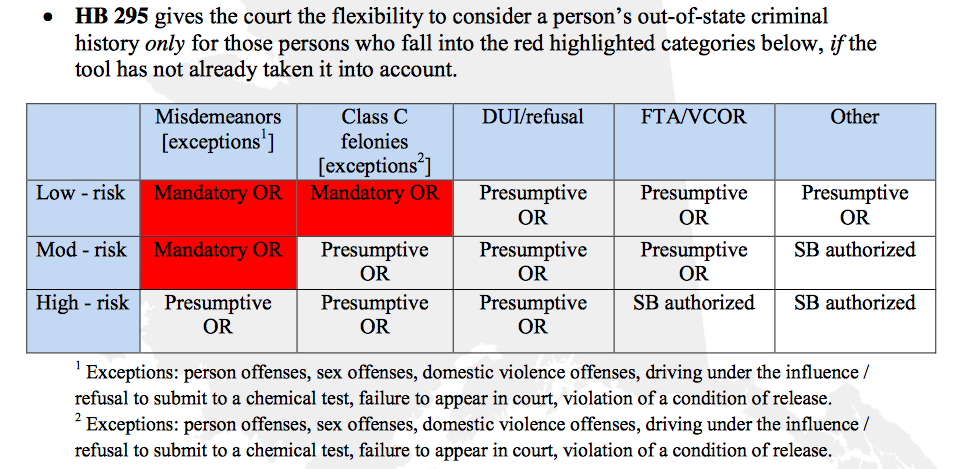The pretrial risk assessment evaluation being used by the Department of Corrections to let prisoners walk free while awaiting trial has no regulatory framework to support it.
A memo from Legislative Research Services says that the Walker Administration has not adopted required regulations to govern the new pre-trial assessment tools, and will probably not adopt them until December, 2018, a year after the tools have been in effect.
According to the memo, “regulations would be in place one year following the start of the program to work out issues, make adjustment, and validate the program and tools being used for Pretrial Services.”
The pretrial tools being used by the Department of Corrections have become known as “catch-and-release,” as violent and repeat offenders are being released immediately by judges who say their hands are now tied.
The lenient arm of the law: More ‘catch-and-reoffend’ car thievery
In the case of repeat offenders Shane Muse, 28, and Crystal Tui, 25, who were nabbed in Anchorage earlier this month for yet another car theft, the new bail system qualified them for release, although as of this writing they are both housed in prison — Muse had also been on the lam for a prior forgery case where he skipped his court date. He is housed at the Anchorage jail, while Tui is at Hiland Mountain Correctional Center.
BACKGROUND
In 2016, Alaska enacted SB 91, a comprehensive criminal reform bill, which, among other things, adopted “evidence-based pretrial reforms” and created a pretrial services program (AS 33.07).
A key part of SB 91 is a new pre-trial unit called the Pretrial Enforcement Division in the Department of Corrections. The Division required an additional 40 state workers and supervises defendants placed in the community while waiting for a resolution of the charges against them.
Pretrial officers perform a risk assessment for each defendant who is arrested and booked in jail. Known as the “Alaska 2 Scale” or “”AK-2S,” the new pre-trial system became effective on Jan, 1, 2018.
In the Muse and Tui case, Muse scored a 2 on a scale of 1-10, and Tui scored 0, meaning she is no risk for reoffending.
RISK ASSESSMENT TOOL IS BEING BETA TESTED
But if Legislative Research is correct, then the pre-trial scoring system being used today isn’t based on solid evidence; the risk profile tool is essentially undergoing testing this year on real offenders.
“The DOC has not adopted any regulations for the pretrial program at this time,” wrote Susan Haymes, manager of the Legislative Research Services.
The Correction Department said in the fiscal note on SB 91 that the regulations would be in effect by Dec. 31, 2017.
Gov. Bill Walker is asking for further changes to SB 91, jumping over the regulatory process to fix aspects of the assessment tool that are letting dangerous felons back out on the street.
Under SB 91, the AK-2S tool doesn’t take into account a person’s out-of-state criminal history.
HB 295 would give the court flexibility to consider that criminal history for some of those being arrested.

A memo from Attorney General Jahna Lindemuth has asked the House and Senate Judiciary Committees to hasten hearings on HB 295. Neither has held a hearing on the bill.
[Read the full text of HB 295 here]
In the story linked above, Shannon Perkins is still out on community supervision, and yet another of the suspects has been released, bringing the total to six out of eight who are not in jail.

The assessment tool will not be ready until December of 2018…yeah, a month after Walker thinks Alaska is ignorant enough to re-elect him.
Don’t forget to vote Judge William F. Morse out with Walker. Tazed David Haeg, lied and said his witness was dead, let another lawyer’s daughter go to jail for killing a man on a bike while she was drinking around her college schedule, allowed Walker to take half the PFD.
Alaska will have a crime spree as long as the laws encourage it, the courts are corrupt and, the people allow it. Alaska can start to change that this November.
Unless they’ve really hired all those people and negotiated the necessary provisions in the labor agreements to have them work a realistic supervision schedule, “supervised release” basically means supervision from 8 – 4:30 M-F by somebody who mostly sits in an office.
Now maybe they have set up a whole new work unit, though I haven’t heard about it, but the typical PO sits in an office and makes appointments with probationers to drop by and see him/her. The DOC has very few vehicles for POs, and we had all sorts of beefs about them using their own cars, so forgive my cynicism, but I suspect that supervised release is a figment of some academic’s imagination.
Comments are closed.